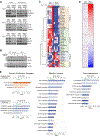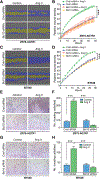The CARMA3-Bcl10-MALT1 Signalosome Drives NFκB Activation and Promotes Aggressiveness in Angiotensin II Receptor-Positive Breast Cancer
- PMID: 29259013
- PMCID: PMC6436094
- DOI: 10.1158/0008-5472.CAN-17-1089
The CARMA3-Bcl10-MALT1 Signalosome Drives NFκB Activation and Promotes Aggressiveness in Angiotensin II Receptor-Positive Breast Cancer
Abstract
The angiotensin II receptor AGTR1, which mediates vasoconstrictive and inflammatory signaling in vascular disease, is overexpressed aberrantly in some breast cancers. In this study, we established the significance of an AGTR1-responsive NFκB signaling pathway in this breast cancer subset. We documented that AGTR1 overexpression occurred in the luminal A and B subtypes of breast cancer, was mutually exclusive of HER2 expression, and correlated with aggressive features that include increased lymph node metastasis, reduced responsiveness to neoadjuvant therapy, and reduced overall survival. Mechanistically, AGTR1 overexpression directed both ligand-independent and ligand-dependent activation of NFκB, mediated by a signaling pathway that requires the triad of CARMA3, Bcl10, and MALT1 (CBM signalosome). Activation of this pathway drove cancer cell-intrinsic responses that include proliferation, migration, and invasion. In addition, CBM-dependent activation of NFκB elicited cancer cell-extrinsic effects, impacting endothelial cells of the tumor microenvironment to promote tumor angiogenesis. CBM/NFκB signaling in AGTR1+ breast cancer therefore conspires to promote aggressive behavior through pleiotropic effects. Overall, our results point to the prognostic and therapeutic value of identifying AGTR1 overexpression in a subset of HER2-negative breast cancers, and they provide a mechanistic rationale to explore the repurposing of drugs that target angiotensin II-dependent NFκB signaling pathways to improve the treatment of this breast cancer subset.Significance: These findings offer a mechanistic rationale to explore the repurposing of drugs that target angiotensin action to improve the treatment of AGTR1-expressing breast cancers. Cancer Res; 78(5); 1225-40. ©2017 AACR.
©2017 American Association for Cancer Research.
Conflict of interest statement
Disclosure of Potential Conflicts of Interest:
S.A. Tomlins is a consultant for and receives honoraria from Roche/Ventana Medical Systems, Almac Diagnostics, Jansenn, AbbVie, Astellas/Medivation and Sanofi. S.A. Tomlins has sponsored research agreements with Compendia Biosciences/Life Technologies/ThermoFisher Scientific, Astellas and GenomeDX. D.R. Rhodes and S.A. Tomlins are Co-founders and equity holders in Strata Oncology. A.M. Chinnaiyan and D.R. Rhodes were Co-founders of Compendia Biosciences.
No potential conflicts of interest were disclosed by the other authors.
Figures







Similar articles
-
MALT1 is a critical mediator of PAR1-driven NF-κB activation and metastasis in multiple tumor types.Oncogene. 2019 Dec;38(49):7384-7398. doi: 10.1038/s41388-019-0958-4. Epub 2019 Aug 16. Oncogene. 2019. PMID: 31420608
-
Ancient Origin of the CARD-Coiled Coil/Bcl10/MALT1-Like Paracaspase Signaling Complex Indicates Unknown Critical Functions.Front Immunol. 2018 May 24;9:1136. doi: 10.3389/fimmu.2018.01136. eCollection 2018. Front Immunol. 2018. PMID: 29881386 Free PMC article.
-
The CARMA3-BCL10-MALT1 (CBM) complex contributes to DNA damage-induced NF-κB activation and cell survival.Protein Cell. 2017 Nov;8(11):856-860. doi: 10.1007/s13238-017-0441-3. Protein Cell. 2017. PMID: 28717989 Free PMC article. No abstract available.
-
Breaking the oncogenic link: BCL10-MALT1 disruption as a precision strike against NF-κB-driven lymphomas.Med Oncol. 2025 Jul 19;42(8):350. doi: 10.1007/s12032-025-02897-w. Med Oncol. 2025. PMID: 40684038 Review.
-
The CBM-opathies-A Rapidly Expanding Spectrum of Human Inborn Errors of Immunity Caused by Mutations in the CARD11-BCL10-MALT1 Complex.Front Immunol. 2018 Sep 19;9:2078. doi: 10.3389/fimmu.2018.02078. eCollection 2018. Front Immunol. 2018. PMID: 30283440 Free PMC article. Review.
Cited by
-
Caspase recruitment domain family member 10 regulates carbamoyl phosphate synthase 1 and promotes cancer growth in bladder cancer cells.J Cell Mol Med. 2019 Dec;23(12):8128-8138. doi: 10.1111/jcmm.14683. Epub 2019 Sep 29. J Cell Mol Med. 2019. PMID: 31565867 Free PMC article.
-
TGFβ+ small extracellular vesicles from head and neck squamous cell carcinoma cells reprogram macrophages towards a pro-angiogenic phenotype.J Extracell Vesicles. 2022 Dec;11(12):e12294. doi: 10.1002/jev2.12294. J Extracell Vesicles. 2022. PMID: 36537293 Free PMC article.
-
MALT1 protease inhibition restrains glioblastoma progression by reversing tumor-associated macrophage-dependent immunosuppression.bioRxiv [Preprint]. 2024 Sep 27:2024.09.26.614808. doi: 10.1101/2024.09.26.614808. bioRxiv. 2024. PMID: 39386586 Free PMC article. Preprint.
-
E3 ubiquitin ligases in cancer stem cells: key regulators of cancer hallmarks and novel therapeutic opportunities.Cell Oncol (Dordr). 2023 Jun;46(3):545-570. doi: 10.1007/s13402-023-00777-x. Epub 2023 Feb 6. Cell Oncol (Dordr). 2023. PMID: 36745329 Free PMC article. Review.
-
The Paracaspase MALT1 in Cancer.Biomedicines. 2022 Feb 1;10(2):344. doi: 10.3390/biomedicines10020344. Biomedicines. 2022. PMID: 35203553 Free PMC article. Review.
References
-
- Senkus E, Cardoso F, Pagani O. Time for more optimism in metastatic breast cancer? Cancer Treat Rev 2014;40:220–8. - PubMed
Publication types
MeSH terms
Substances
Grants and funding
LinkOut - more resources
Full Text Sources
Other Literature Sources
Medical
Molecular Biology Databases
Research Materials
Miscellaneous

